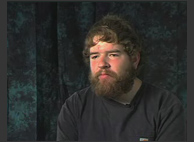| NIMH: Autism Spectrum Disorders | |
| NICHD: Autism and the MMR Vaccine | |
| Richard, Age 52 | |
| Jeff, Age 35 | |
| NIMH: Autism Spectrum Disorders (pdf) | |
| CDC: Learn the Signs Information Card (pdf) | |

What is Autism?
The autism spectrum disorders are more common in the pediatric population than are some better known disorders such as diabetes, spinal bifida, or Down syndrome. Prevalence studies have been done in several states and also in the United Kingdom, Europe, and Asia. A recent study of a U.S. metropolitan area estimated that 3.4 of every 1,000 children 3-10 years old had autism. This wide range of prevalence points to a need for earlier and more accurate screening for the symptoms of ASD. The earlier the disorder is diagnosed, the sooner the child can be helped through treatment interventions.
Pediatricians, family physicians, daycare providers, teachers, and parents may initially dismiss signs of ASD, optimistically thinking the child is just a little slow and will "catch up." Although early intervention has a dramatic impact on reducing symptoms and increasing a child's ability to grow and learn new skills, it is estimated that only 50 percent of children are diagnosed before kindergarten.
All children with ASD demonstrate deficits in:
- social interaction
- verbal and nonverbal communication
- repetitive behaviors or interests
In addition, they will often have unusual responses to sensory experiences, such as certain sounds or the way objects look. Each of these symptoms runs the gamut from mild to severe. They will present in each individual child differently. For instance, a child may have little trouble learning to read but exhibit extremely poor social interaction. Each child will display communication, social, and behavioral patterns that are individual but fit into the overall diagnosis of ASD.
Children with ASD do not follow the typical patterns of child development. In some children, hints of future problems may be apparent from birth. In most cases, the problems in communication and social skills become more noticeable as the child lags further behind other children the same age. Some other children start off well enough. Oftentimes between 12 and 36 months old, the differences in the way they react to people and other unusual behaviors become apparent. Some parents report the change as being sudden, and that their children start to reject people, act strangely, and lose language and social skills they had previously acquired. In other cases, there is a plateau, or leveling, of progress so that the difference between the child with autism and other children the same age becomes more noticeable.
NIMH



